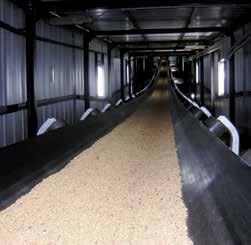
2 minute read
SIG SPA
precision and time are key. Unsurprisingly, inherent with limitations, human labour would not only be time-consuming but also slow. On the other hand, storage, drying and processing of products becomes easier and efficient by using a conveyor.
• Cost effective (reduces costs)
Advertisement
Besides, imagine the sheer scale of the cost of labour costs a company would be compelled to incur such as recruitment, wages, training, benefits and retention. Thus, from that perspective, the adoption of conveyors would reduce costs.
• Reduces safety risks and breakage
Conveyor systems eliminate the safety risks workers may be exposed to. The fewer workers will no longer need to be manually carrying heavy loads which can lead to injuries. Furthermore, breakage or damage to materials is reduced .
Wise investment decisions
In all the processes of harvesting, processing and transporting, a conveyor should be selected based on the correct production needs. It is only then that the client can be rest assured of the much-desired output from conveyors. The importance of wise decisions has to be highlighted.
This is because, just like in other industries, conveyors used on farming equipment are exposed to challenging conditions such as strong abrasion, tears, temperature variations, exposure to water, oil and grease, etc. Consequently, they should demonstrate excellent resistance to abrasion, cuts and tears. These features increase life cycle, which reduces maintenance costs.
That is why after a decision to invest in a conveyor system; a farming business has to know about its specific needs, as every conveyor is engineered for a particular application. Conveniently, OEMs have made optimising and custom designing a standard. Generally, some of the aspects considered in designing cover the following: the type of materials that need to be moved, as well as the distance, height, speed the materials need to move, and available space and configuration.
Three critical questions to ask
It is essential to seek accurate answers to the following questions to establish if the conveyor system is fit for purpose: • Is the conveyor system for the correct application I am looking for? • What is the desired trait of your conveyor system change? • Is the conveyor of the required quality and durability?
The Conveyor Equipment Manufacturers Association (CEMA) is an association that provides the conveyor industry with design, engineering, application, and safety standards in the USA, which are also referenced in other countries. It has invaluable advice to industry on the choice of conveyors.
“For each task, consider how the desired traits of your conveyor system change. For in-field work, you’ll more than likely require an enclosed, inclined conveyor that will quickly and efficiently load the harvest into transport vehicles. As for when it reaches a food processing facility, you will require a permanent fixture that is perfectly sculpted into the infrastructure of your facility.”
Overall, in other regions, where their take up is high, conveyors have brought about massive benefits to farming businesses. Evidently, businesses in Africa can follow suit and adopt conveyor systems for their respective materials handling needs.











